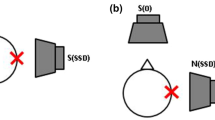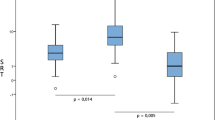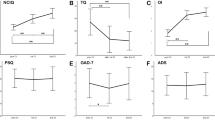Abstract
Binaural sound reception has advantages over unilateral perception, including better localization and sound quality as well as speech and tone reception in both quiet and noisy environments. Up to now, most active middle ear implant (AMEI) users have been unilaterally implanted, but patient demand for an implant on the other side is increasing. Ten bilaterally-AMEI implanted native German-speaking adults were included in the study. The Oldenburg sentence test was used to measure speech reception thresholds in noise. The subject’s signal-to-noise ratio (SNR) at a speech reception score of 50 % was calculated for different noise conditions. SRT was measured as a function of noise condition (nc) and listening condition (lc)—for example, SRT (lc, nc), with nc from S0N0, S0N-90, or S0N90 and lc from left, right or both. For each noise condition, the squelch effect and the binaural summation effect were calculated. Patients in this study demonstrated improvement with bilateral AMEIs compared to right or left AMEI only in all three tested listening conditions. Statistical significance was found in the S0N0 condition to favor usage of bilateral AMI versus either the right or left side only. The benefits of binaural hearing are well known, also in normal-hearing individuals. In the future every bilateral implantation should be a part of the clinical routine. Bilateral implantation can help to reduce problems in background noise and restore directional hearing.





Similar content being viewed by others
References
Ricketts T, Lindley G, Henry P (2001) Impact of compression and hearing aid style on directional hearing aid benefit and performance. Ear Hear 22:348–361
Saliba I, Calmels MN, Wanna G et al (2005) Binaurality in middle ear implant recipients using contralateral digital hearing AIDS. Otol Neurotol 26:680–685
Garin P, Schmerber S, Magnan J et al (2010) Bilateral vibrant soundbridge implantation: audiologic and subjective benefits in quiet and noisy environments. Acta Otolaryngol 130:1370–1378
Stern RM Jr, Colburn HS (1978) Theory of binaural interaction based in auditory-nerve data. IV. A model for subjective lateral position. J Acoust Soc Am 64:127–140
Boheim K, Mlynski R, Lenarz T et al (2012) Round window vibroplasty: long-term results. Acta Otolaryngol 132:1042–1048
Beleites T, Neudert M, Beutner D et al (2011) Experience with vibroplasty couplers at the stapes head and footplate. Otol Neurotol 32:1468–1472
Wagener K, Brand T, Kollmeier B (1999) Enwicklung und evaluation eines Satztests für die deutsche Sprache 38(2):44–56
Wagener K, Brand T, Kollmeier B (1999) Enwicklung und evaluation eines Satztests für die deutsche Sprache 38(3):86–95
Bronkhorst AW, Plomp R (1988) The effect of head-induced interaural time and level differences on speech intelligibility in noise. J Acoust Soc Am 83:1508–1516
Noble W, Gatehouse S (2006) Effects of bilateral versus unilateral hearing aid fitting on abilities measured by the Speech, Spatial and Qualities of Hearing Scale (SSQ). Int J Audiol 45(2):172–181
Noble W (2006) Bilateral hearing aids: a review of self-reports of benefit in comparison with unilateral fitting. Int J Audiol 45(1):S63–S71
Wolframm MD, Giarbini N, Streitberger C (2012) Speech-in-noise and subjective benefit with active middle ear implant omnidirectional and directional microphones: a within-subjects comparison. Otol Neurotol 33:618–622
Peters BR, Wyss J, Manriqe M (2010) Worldwide trends in bilateral cochlear implantation. Laryngoscope 120:17–44. doi:10.1002/lary.20859
Holmes AE (2003) Bilateral amplification for the elderly: two aids better than one? Int J Audiol 42:2S63–2S67
Author information
Authors and Affiliations
Corresponding author
Ethics declarations
Conflict of interest
All authors disclose that there is no conflict of interest.
Financial disclosure
All authors declare that neither financial interests nor financial support by companies exists. Furthermore, there are no financial interests the author may have in companies or other entities that have an interest in the information in the Contribution. All authors declare that the manuscript has not been published previously nor is it under review by another journal. The paper has not been presented to any professional society.
Rights and permissions
About this article
Cite this article
Wolf-Magele, A., Koci, V., Schnabl, J. et al. Bilateral use of active middle ear implants: speech discrimination results in noise. Eur Arch Otorhinolaryngol 273, 2065–2072 (2016). https://doi.org/10.1007/s00405-015-3783-6
Received:
Accepted:
Published:
Issue Date:
DOI: https://doi.org/10.1007/s00405-015-3783-6




